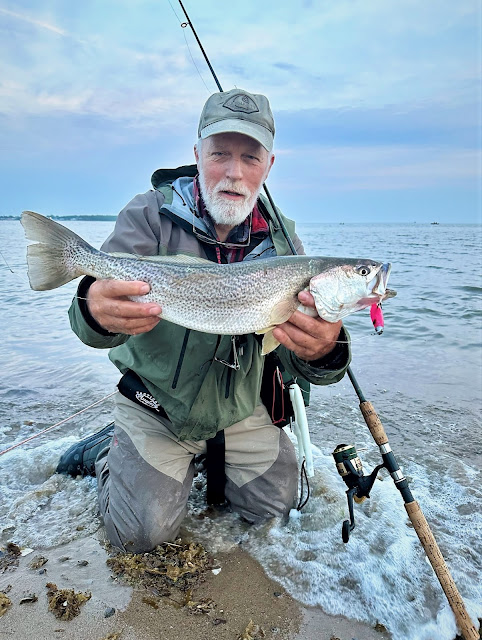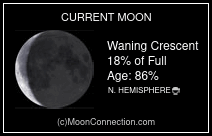Monday, December 18, 2023
Best Laid Plans
Monday, September 18, 2023
Artificial Intelligence
I love everything about American
eels. They are arguably the most effective and versatile bait when
targeting striped bass. Many a book chapter, magazine article, and blog post
have been written about their ability to entice stripers into gulping them down
like candy. An eel was responsible for my largest bass ever landed and I’m sure
the same can be said by countless anglers up and down the Striper Coast.
For a long time now, lure makers have
been trying to, with varying levels of success, duplicate the American eel’s
shape, suppleness, and action. I have been fishing eels in nearly every fashion
possible for as long as I can remember and don’t plan on giving them up
entirely anytime soon. All that said, they are expensive, can be a pain to deal
with, and are sadly becoming scarcer as the years tick by.
Companies like Lunker City, Hogy,
RonZ, Al Gag’s, Berkley were some of the OGs of my early days of fishing eel
imitations, and they still make great baits today. However, it’s been
intriguing to witness the arms race of long, slender soft-plastics come
to market over the last 20 years. By names like Got Stryper, Game On!, Fish
Snax Lures, JoeBaggs, Zinger Baits, and Gravity Tackle to name a few. There are
limitless combinations of size, color, and rigging options available to today’s
angler for nearly any situation they could encounter. So much so the choices
can be overwhelming.
Over time, I have been building
up my arsenal of soft-plastics and my confidence in using them. I am starting
to find more consistency in my success and part of that can be attributed to selecting
the right bait and rigging style to match the spot and its conditions on a
given outing. Like in every kind of fishing that I do, it has been a fun, never
ending journey of learning. The farther down this rabbit hole I go, the more I
realize how much there is still to learn, explore, and experiment.
We’re on a loop. Enjoy the ride.
 |
| The author with a healthy striped bass that fell for a 13.5" GT eel rigged on a 1/2 oz. jig head. |
Monday, September 11, 2023
Triathlon Bass
While there was no swimming or
running involved, this lazy man’s triathlon did have its share of driving,
cycling, and walking. An end-of-summer fishing adventure with a good amount of
time and energy expended to reach a chosen spot; effort that would pay off in
spades just a few casts in.
Wearing wetsuits and standing in
water 50-yards from shore on a dark night, it was challenging not to think
about the plethora of brown sharks that chomped striped bass catches all over Long Island Sound this
summer. Jim, the trip planner and my host for the
night, started with a live eel. I opted for a lure that punched through the light
breeze to reach the dying current, which was going from right to left around a
rocky point with an ebb tide.
This lure was an Xplorer, the
brainchild of a talented angler and plug builder named John Stirpe. Made of
resin with a portion of its core being urethane foam, it is a unique and
versatile floating swimmer that digs on a fast or slow retrieve, flashing a
super realistic paintjob. It was gifted to me by my pal Eddie, a fellow fishing
and artifact junkie from Massachusetts. He has fooled a number of plus-size
striped bass over the past few seasons on Xplorers. Knowing I had coveted one
for some time, Eddie generously mailed me a plug from his personal stash with
the understanding that I would fish it hard.
Our first casts came right after full
darkness set in. I was aiming to about 1:30 on a clock face. On my second cast,
my lure had just splashed down and something whacked it, even before I had a
chance to put my braid on the line roller. A good omen no doubt and I hollered
to Jim to give him a heads up. While retrieving the very next cast, a fish
slammed the Xplorer and immediately thrashed around on the surface. It then
made a bee line right at me and I reeled furiously to stay in contact. When the
bass realized it was hooked, she did an about face and flexed her muscles,
peeling an impressive amount of line in the process.
This was the biggest test yet for
my 'Montauk Eel Rod,' a Lamiglas blank cut and wrapped in 2015 by a friend and
expert rod builder, Billy DiLizio. A rod soft enough to throw and feel lighter
offerings, yet with enough balls to put the screws to big striped bass, which
is exactly what I was doing in this moment for fear of having it bitten in half
by the taxman. A strong fish, but beaten pretty quickly and still green when my
Boga Grip clasped its lower lip.
In the faint beam of my headlamp,
the bass did its best planking impression just under the surface, allowing me
to snap a half decent photo with the Xplorer still in its jaw. Before letting
her go, I lifted the fish quickly out of the water and watched the numbers on
the scale drop to a hair below the 36 mark. This was a notable catch for me in
a few ways. It was the largest striped bass I had caught in years, the largest
ever landed on that particular rod, and my largest ever using an artificial lure.
Stoked doesn’t begin to describe it. Do I wish I had gotten a better photo? Yes,
but there was no good way to document it without bringing the fish to shore and
risking its health and possibly missing out catching other fish. I took solace
in how strong she bolted away for deeper water.
The fish were there as soon as we arrived, and likely before that, though they seemed to vacate the boulder field soon after, as the moving water grinded to a halt. Jim ended up losing what felt and sounded like another big bass on an eel and I had one more hit on the swimmer. That was it, though we kept trying for a while before the long walk, pedal, and drive back. My partner was on vacation and could have kept fishing for another 12 hours, but I had to be presentable at work the next morning. Still, I wouldn’t have changed anything. I floated on air the whole way home and for some time after.
That was a memorable fish and experience, and I am grateful for the many cool pieces that came together to make it possible—from Jim organizing the trip, to Billy wrapping the rod, to John building the plug, to Eddie mailing it to my door. One of the greatest things about fishing is, you just never know what is going to happen on any given outing.
Sunday, August 27, 2023
Vacation Blitz
“Lotto fishing,” quipped the Cape Codder from across the street. “You need to be in the right place at the right time and get lucky.”
My family and I were renting the same cottage that we have
each summer for the last several years. While chats with the neighbor are
minimal during our stay, I always take stock in what he says. A hardworking
waterman, in summers past he had gifted us freshly-raked little necks. This
time he offered fishing advice, or at least hope that something special could
happen if luck was on my side.
There was a pile of striped bass feeding just offshore of
the outer beaches, and they could easily follow bait to within casting range at
a moment’s notice, but you needed to be there when it happened. Reports from other
anglers and tackle shops nearby confirmed as much. So, while it was a family
vacation, I put in as much time fishing as I could get away with.
Our third day there was the Sabbath. We spent it at our
favorite bayside beach. I brought my fly gear along and spotted a few spooky
stripers on the flats during low flood tide. Despite some casts in front of
moving targets, there were no takers. Come to find out, these bass have been dialed-in
on crabs more than usual and I made the mistake of having only sand eels in my
fly box. The lesson here being that you should always hit the local fishing
shop at the beginning of vacation. Even still, it was really neat to see stripers
hunt the shallows in August, and I hope the adrenaline rush from sight-casting never
fades.
After the Bay, we went mini golfing, grilled burgers back at
the cottage, then biked down the street for homemade ice cream. It was still
early, around 6 p.m., when we decided on a whim to see the water again, this time
the ocean. I put the surf rod on top of the truck just in case. I had fished
and blanked on this stretch of shoreline the previous two sunrises. No signs of
fish or bait that I could tell, but the large seals cruising the surf line hinted
otherwise.
The evening beach crowd was in full effect when we arrived.
Large groups of vacationers sitting in Tommy Bahama chairs, set up in
half-moons facing the water. I spiked my rod and laid a blanket on the beach
berm, but no one sat. We all stood there soaking in our surroundings, enjoying
the waves crashing at our feet and the sun getting lower in the sky behind us.
My wife pointed it out first. A few hundred yards to our
left, there was a large patch of water darker than the rest, parallel to shore
with a commotion of birds flying around it. It was the pot of gold at the end
of the rainbow; a bonified blitz that was slowly moving south towards us. I
could see a line of fishermen at the water’s edge in the distance, but it was
hard to make out if they were hooked up or not. To be honest, I didn’t freak
out right away because the action looked beyond casting distance. Once I saw
splashes tighter to shore, on the inner side of the main body of fish, I bid
adieu to my family and began a brisk walk to intercept the melee.
The walk changed to a jog when bent rods came into view. The
beachgoers I passed were completely oblivious to what was going on, at least
for the time being. I stopped well short of the nearest angler, it was a kid
from Canada who was catching hickory shad on epoxy jigs when we first arrived. The
fish he was casting to now were striped bass, thousands of them gorging on
unidentified baitfish.
The plug I had been using most on the trip to this point was
a pencil popper in a green mackerel pattern made my 247 Lures. That was before
I broke it off earlier in the day and watched it bob-away in shark-infested
waters. What I reached for next was more sentimental, a flat-bottomed pencil turned
decades ago by the late John Haberek. I
clipped on the Hab’s, leaned back and launched the furthest cast I could. A
striper crushed it on the surface before a full turn of the reel handle. It had
been a long time since I had hooked one in the Atlantic surf—it felt damn good.
When the bass came through the last
wave and hit the wet sand, a few inquisitive kids stepped forward asking all
kinds of questions. As instructed, they avoided the pointy dorsal fin and ran
their fingers down the flank of the fish before watching it dart back into the
wash. By now my family had caught up and served as a cheering section and
paparazzi rolled into one. The highlight of the whole vacation was sharing the
unfolding scene with them. A second cast into the outskirts of the frothing
water produced a tight line nearly as fast as the first. Another bass, not
especially large, but aggressive and punching above its weight class in the
ocean currents.
The next 20 minutes went on like that...wash, rinse, repeat. Acres of boiling water sluggishly moved down the beach as anglers followed along, fighting and releasing fish, then leap-frogging others who were hooked up in order to get in position for their next cast. The noncombatants behind us watched in awe at what was taking place. There was good reason to be amazed. I had been visiting and fishing the Cape for more than two decades and had never stumbled into anything like it. Only once before did something remotely similar happen to me on vacation, about 25 years earlier with my Uncle Frank in Charlestown, Rhode Island, but even then, that blitz was all bluefish.
While it all felt surreal, I was ready for this exact scenario,
beaching a half dozen stripers up to the mid-30-inch class and dropping a few others.
By the time we made it back to our blanket, the top-water action drifted far enough
away from shore to make the decision to call it a night easier. A few anglers
kept up in pursuit, but the damage was done was for us. My girls and I absorbed
what just went down while enjoying the last frames of sunset.
Each of the next four days, we spent significant time along the
Cape’s outer beaches and never saw another fish or bent rod, still marine life
was all around us. We were treated to an incredible display of whales a few hundred
yards offshore, humpbacks full-on breaching and bubble-net feeding for hours. Another
lively sighting was a giant ocean sunfish, mostly exciting because its fin poking
out of the water looked awfully like a shark fin as it passed us on the beach.
Toward the end of our trip, I visited a tackle shop to stock
up on crab flies and replace the pencil popper I had lost earlier in the week. In
comparing notes with one of the employees, he experienced the same blitz we did, and shared that the next three evenings at
that beach were dead; no signs of life anywhere. In turns out, we were in the right place at
the right time and got lucky. That’s lotto fishing for you.
Friday, July 14, 2023
Monday, May 22, 2023
Runners of the Tide
While I hardly enjoy a packed beach, I'll put up with it a few times each May. Thankfully when prime tides are very late or very early, even the most popular spots can be a ghost town. Catching the inaugural squeteague of spring almost feels like getting a monkey off my back. They can be challenging, partly due to the finite window of time we find them from shore with any kind of consistency, and partly because hooks often lose purchase in their weak mouths after seizure-like headshakes. Patience and a loosened drag can help.
A big draw for me is witnessing the overall natural spectacle that is taking place; a convergence of fish, shorebirds, and arthropods that has occurred here each spring for millennia. Also, when everything lines up in your favor, you can experience a window of unparalleled action. Waves of weakfish charging up the beach and multiple rods bending in unison. A brief period with a bite so intense that you better make sure your offering is in the water and swimming well.
We were fortunate to experience two evenings like that recently, where for about 30 minutes it was lights-out action. Up and down the waterline, all you saw were anglers in various stages of hooking, fighting, or beaching weakfish. I landed more in one trip than I had in multiple years. Some of them hit my jig only a rod's length from my feet. It was nutty for a little while and then it wasn't. That's the way it goes sometimes. And the more time you put in, the better the odds you'll eventually stumble into events like that. I am just glad that I was a small part of it, standing there right next to my uncle.
Sunday, April 30, 2023
Opening Daze: 2023
“Warmest Opening Day Weekend yet.”
It started as a simple, and quite inaccurate, weather prediction made by Tommy
before our annual spring pilgrimage to the West Branch Farmington River a few
years back. It was so cold, wet, and raw that particular weekend, that the
botched forecast became lore amongst our crew, and the acronym WODWY has lived
on in text messages leading up to the camping trip ever since.
The running joke finally turned
reality this year. Warm was actually an understatement; it was straight up shorts-weather
for the first two days of our outing. While 80s in April felt a bit out of
place, no one dared complain with hard frosts and deluges of years past seared
into memory. Of course, it couldn’t be beach conditions the entire stay, and
what’s Opening Day Weekend without precipitation? It rained just enough at the finish line to necessitate drying out gear in the ensuing days.
In between the warmth and the
rain, we packed in another banner celebration of spring. We ate, we drank, hell,
we even left camp twice to fish. Hendricksons were hatching, but the river's resident trout hadn’t
yet decided to eat them. Even so, we were grateful for the unfussy, freshly-stocked rainbows that tightened our lines. All in all, WODWY was an awesome experience. One more
good notch in the belt of tradition.











































































.jpg)



























